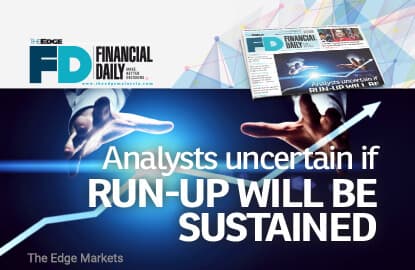
KUALA LUMPUR: After a disappointing 2016, which saw analysts lower their target for the FBM KLCI, there is a somewhat more optimistic feeling about the prospects for 2017 after the benchmark index crossed the 1,700-point mark last week.
The market’s run-up is not out of place among regional and global markets, but will the uptrend be sustained?
Analysts are careful to paint two sides to the picture. On one hand, commodity prices including crude oil and palm oil are up, giving an advantage to local producers and exporters.
However, “market exuberance” alone will not be enough to boost markets for long, one head of research opined.
“Whether or not the rally is sustainable is a big question,” he told The Edge Financial Daily over the phone.
The FBM KLCI last breached the 1,700 mark in March 2016 but only hovered above it for a little over a month, subsequently sinking to as low as 1,621.21 in May. Since then, the key barometer has struggled to make a comeback, only getting close at 1,699.89 on Aug 16.
Last Friday, the index closed at 1,707.68, flat on daily trade but up some 4.08% year to date (YTD).
Although the FBM KLCI clearly rebounded in January and sentiments seem to have improved, the index still lags behind its regional peers in terms of recovery, said Ang Kok Heng, chief investment officer at Phillip Capital Management Bhd.
“Last year, if not for the weak ringgit, our market should have seen a positive gain,” Ang said.
Regional indices have rallied with varying strengths YTD. Singapore’s Straits Times Index has been the most bullish, up some 10.21% to 3,107.65.
Meanwhile, Hong Kong’s Hang Seng Index and South Korea’s Kospi also outshone their peers, rising 9.13% and 7.66% YTD respectively.
“This year we are just playing catch-up [with regional markets], but even now we are still behind them,” Ang said, although he thinks there is still room for the local market to reach similar heights.
“In fact, if you look at the US Dollar Index (which measures the US dollar against a basket of currencies), it’s back to the US$100 (RM445) level again, so we see some foreign funds coming back to this region,” he added.
The US Dollar Index registered US$100.47 at the time of writing, down from a five-year high of US$103.30 on Dec 28, 2016.
According to Areca Capital Sdn Bhd chief executive officer Danny Wong Teck Meng, investors have started to take profit from the high US dollar with over US$2 billion flowing back into the region over the last few months, with the Malaysian market seeing nearly US$100 million net inflow of foreign funds since January.
Wong was more upbeat about future prospects following what is seen as a recovery of the US economy.
“Emerging markets have actually gone up in the six to nine months after the tightening of US Federal Reserve interest rates after the last two or three times [rates were hiked],” Wong told The Edge Financial Daily via telephone.
Another contributing factor to the rally is a recovery in corporate earnings, which had bottomed out after declining over the past couple of years, Wong said.
“The weakening ringgit might not be as bad as we thought, what with the recovery of the commodity prices,” he added.
However, another analyst who declined to be named opined that despite the improvement in market sentiment, “things are not as good as they seem”.
“For a market rally to be sustainable, there need to be very compelling reasons. High yields, high earnings and high growth … none of those factors currently exist,” the analyst said.
Despite popular opinion that the government may be looking to boost spending ahead of the 14th General Election, which is due by March 2018, the analyst also raised concerns over ballooning government debt.
“Good commodity prices are only part of the story. We can [also] look at government spending, but I think whether investment and consumption levels are up to expectation is more important,” added the analyst.
The question now is: Is it still a good time to invest in Malaysian equities?
“We believe the current rally can last until May probably,” said Chris Eng, the head of research at Etiqa Insurance Bhd.
“We have been advocating investors to buy into the Malaysian stock market since August 2016 given that we saw improving economic fundamentals in the first half of 2017,” he said in an email response.
According to Wong, 2016 would have been the best time to invest in the market, but he remains optimistic about Bursa Malaysia this year.
“It won’t be a smooth rally — on and off the market may see pullbacks for healthy correction,” Wong said.
He highlighted political developments in Europe and US President Donald Trump’s policies as key developments to keep an eye on.